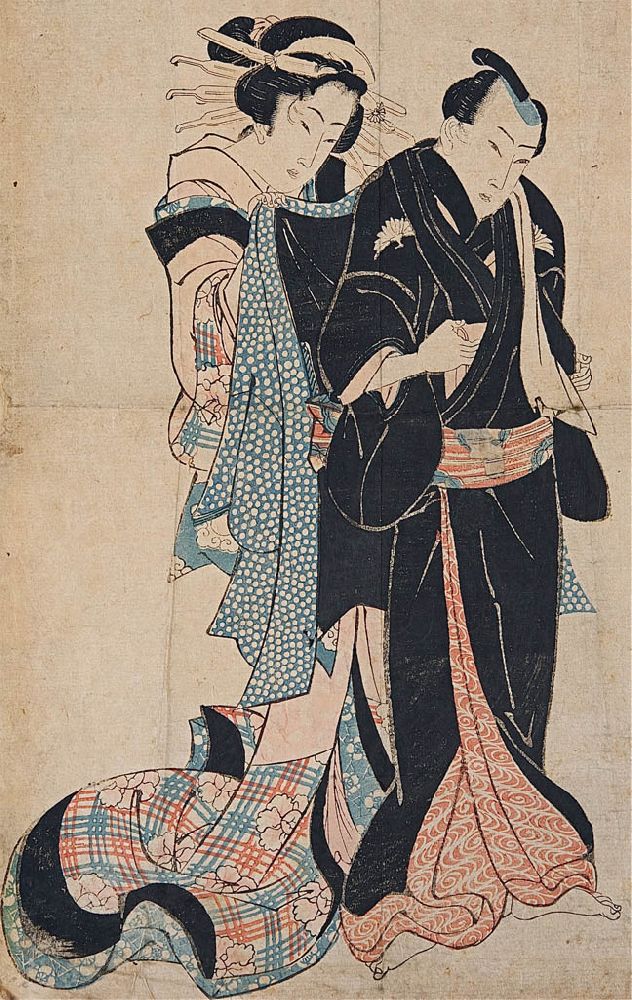

Title: Colored Japanese Woodblock print by Artist Kikugawa Eizan
Shipping: $29.00
Artist: N/A
Period: 18th Century
History: N/A
Origin: N/A
Condition: Good
Item Date: 1787 to 1867
Item ID: 3776
Eizan (Kikugawa) (Japanese, 1787-1867) Geisha attending Samurai. Woodblock print in colors, apprx. 13" x 9-1/4", unframed. Signed at the right side, a publisher's seal of Mori-ya Jihei (Mori-Ji) Kinshindo (ca. 1800-1850), and a seal (ca. 1790-1804). Condition: Wear, soils, folds and creases, losses; see detail photograhs. The Edo or Tokugawa period (1605-1868) in Japan's history witnessed the rise of the chōnin, the prosperous urban-based merchant class. The chōnin were deprived of participation in the political running of the country by the military elite. Therefore they channelled their energies into developing a vibrant consumer culture, involving leisure pursuits, patronage of the arts and an indulgence in material luxury. Their playground for displays of conspicuous consumption was Edo's (modern Tokyo) Yoshiwara district, which housed the city's licensed brothels, theatres and tea houses. In the Yoshiwara district, spectacularly robed oiran (the highest ranking courtesans) could be seen parading with their attendants on their way to an assignation. This could take an inordinate length of time over a relatively short distance as the courtesan exploited the impact of her superb appearance by walking in a highly mannered style at a very slow pace. The spectacle of promenading courtesans was a favourite subject for ukiyo-e artists. Eizan, took delight in depicting the courtesan's highly ornate robes, an important element of parade and display. They are decorated with poem cards or shikishi (popular motifs for textile designs) which were used for writing poetry and painting small images. Images in books were almost always in monochrome (black ink only), and for a time art prints were likewise monochrome or done in only two or three colors. The text or image would first be drawn onto washi (Japanese paper), and then glued onto a plank of wood, usually cherry. Wood would then be cut away, based on the outlines given by the drawing. A small wooden hard object called a baren would be used to press or burnish the paper against the inked woodblock, thus applying the ink onto the paper. Although this may have been done purely by hand at first, complex wooden mechanisms were soon invented and adopted to help hold the woodblock perfectly still and to apply proper pressure in the printing process. This would be especially helpful once multiple colors began to be introduced, and needed to be applied with precision atop previous ink layers. Text was nearly always monochrome, as were images in books, the growth of the popularity of ukiyo-e brought with it demand for ever increasing numbers of colors and complexity of techniques.
Link: http://en.wikipedia.org/wiki/Kikukawa_Eizan
Kikukawa Eizan (1787-1867) (Japanese: 菊川 英山) was a designer of ukiyo-e style Japanese woodblock prints. He first studied with his father, Eiji, a minor painter of the Kanō school. He then studied with Suzuki Nanrei (1775-1844), an artist of the Shijō school. He is believed to have also studied with the ukiyo-e artist Totoya Hokkei (1790-1850). He produced numerous woodblock prints of beautiful women in the 1830s, but then abandoned printmaking in favor of painting.
This artist should not be confused with Harukawa Eizan, a designer of ukiyo-e woodblock prints who was active in the 1790s